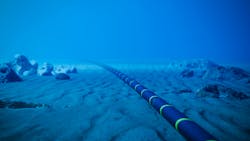Shortage of submarine power cables poses threat to offshore wind market
Bruce Beaubouef * Managing Editor
The offshore wind energy industry is increasingly beset with a host of problems, rising costs, insecure supply chains, and failing turbine blades. But the industry is now confronting another challenge that is at least as daunting as the others: a shortage of the submarine power cables needed to bring that power to shore.
As developers seek to advance their offshore wind energy projects, they are increasingly finding that these cables are very expensive and in short supply. A global surge in wind projects has intensified demand for HVDC (high voltage direct current) subsea cables, with forecasts indicating that global submarine cable demand could double by 2030.
Cable manufacturers are reporting backlogs of 12 years-plus, according to a report from HSBC Holdings Plc. And, amidst a surge in the cost of copper, prices of power wire and cables jumped more than fivefold from 2004 to 2022. Some submarine power cables can now cost about $1 million per half mile to purchase and install.
That is placing utility companies and wind energy developers in a precarious position, as they often have little to no negotiating power. There are only a handful of mostly European companies that make these specialized cables. Three European companies – NKT (Denmark), Prysmian (Italy), and Nexans (France) – reportedly control 75% of the HDVC cable market. And the Financial Times recently reported that production capacity for most submarine power cable manufacturers is fully booked until the late 2020s.
Cable demand is ramping up exponentially, Nexans officials say. Orders for Nexans and its competitors have risen tenfold in the past few years, executives say. The Nexans cable factory in Halden, Norway, is reportedly sold out until at least 2028.
These market conditions could see countries other than China face HVDC cable shortages in the near future. China has managed to avoid cable shortfall issues having devoted substantial resources to bolstering its HVDC sector over the past several years. The country has developed a number of domestic companies that predominantly cater to its own offshore wind market.
Moreover, technological needs further compound the problem, as larger, longer, and higher-voltage cables are required for bigger and more distant offshore wind farms. Upgrades to manufacturing equipment and bespoke cable production can exacerbate supply chain challenges. The looming shortage of cables not only threatens project timelines but also raises concerns among insurers, driving up premiums and leaving projects without cover.
Then there is the challenge of laying the cables. Only a limited number of vessels exist that are capable of laying, repairing, and maintaining these cables – a little over 60 such ships operate worldwide, many of which are aging. This shortage hinders the progress of offshore wind farm developments. And with competing priorities around the installation of data submarine cables, there can potentially emerge competition between data and HVDC cable manufacturers as both sectors experience growth in demand.
This competition underscores the broader challenges facing the offshore wind industry and highlights the need for careful planning and collaboration to address capacity constraints.
In the current market environment, utilities and offshore wind developers often find themselves in an unfavorable position. Gilles Etheimer, chief procurement officer at Réseau de Transport d’Électricité, France’s electric grid operator, bemoaned the “tremendous” price increases and a lack of bargaining power. As quoted by Bloomberg, he is reported to have lamented: “We are not negotiating—they are imposing.”
Shore to shore power
And it’s not just offshore wind farms that are raising demand for submarine power cables. In Europe, there is a growing market for submarine cables that will move electricity from onshore power producers through the ocean to onshore power markets. One of these is the proposed Celtic Interconnector project, which involves running a submarine power export cable from Finistère, France, to East Cork, Ireland, through the Celtic Sea. The developers, France’s Réseau de Transport d’Électricité and its Irish partner EirGrid, reportedly paid €750 million for 1,000 kilometers (621 miles) of Nexans cables to stretch from France to Ireland. An even larger project is the proposed Great Sea Interconnector (GSI), which will require 1,200 km (750 mi) of submarine HVDC power cable that to connect the Israeli, Cypriot, and Greek power markets to the European power grid.
Buying in bulk
To reach net-zero carbon emissions by 2050, the world will need to triple its 2023 level of spending on power grids by the middle of the next decade, according to BloombergNEF. Supply chain shortages – particularly submarine power cables – could delay the energy transition, analysts say.
Utilities are responding to scarce cable supplies by making enormous purchases far in advance of their need. Dutch grid operator TenneT Holding BV is investing €160 billion in new capacity, including wind farms and multiple submarine cable systems off the coasts of the Netherlands and Germany. One analyst estimated that, taken together, all of these submarine power systems would add up to 10,000 kilometers of cable – nearly the distance from New York to Dubai.
Normally, according to one analysis, TenneT would bid out the cables in pieces. But in these market conditions, it decided instead to put out a €30-billion tender for agreements to buy cables, power transformers and specialized vessels to transport and install the cables and offshore platforms. It was a decade-long commitment. That made it worth the suppliers’ time and money to increase production now. NKT was one of the companies awarded a Tennet contract. “Larger commitments over [a] longer time is the way to create certainty for this industry,” said Claes Westerlind, CEO of NKT Holding, as reported by Bloomberg. This is important, Westerlind said, “both to continue to operate as we are today, but also to be able to take brave decisions going forward on investments.”
Using a similar approach, UK utility National Grid Plc announced a plan to spend £21-billion ($27 billion) on roughly 14,000 kilometers of high-voltage cables. Over the next decade, Britain’s growing offshore wind industry is expected to use these cables to move electricity from offshore areas with strong wind resources to growing power markets in the south of England. “To gain a slot on the manufacturing capacity, we’re having to make upfront payments,” says John Pettigrew, National Grid’s CEO, as reported by Bloomberg.
Increasing supply
Cable manufacturers have announced plans for new and expanded factories over the past year, a development that offers the prospect of increased supply.
Earlier this year, Sumitomo Electric Industries Ltd. opened a new office in Glasgow to serve the growing offshore wind market in Scotland. Sumitomo is also building a new £350-million factory at the Port of Nigg in northern Scotland. When it starts operating in 2026, it is expected to be able to produce hundreds of kilometers of cables annually. Previously, Sumitomo served only the Japanese cable market, but it has now made a couple of major sales in Europe. One of these was for the 140-kilometer submarine cable called Nemo Link that moves power in each direction from the UK to Belgium. It was placed in service in 2019. “It’s a big demand increase we’re seeing now and for the next 15, 20 years,” said Toshiyuki Furuhashi, general manager for power projects for Sumitomo, as quoted in the Bloomberg report.
South Korea-based offshore wind cable manufacturer, LS Cable & System, has decided to build a manufacturing facility for HVDC subsea cables in Chesapeake, Virginia, which the company says will be the largest factory of this kind in the United States. Construction is scheduled to begin in 2025 and the subsea cable factory is expected to be completed in 2027.
The announcement comes as Dominion Energy has begun installing monopiles, or wind turbine foundation posts, 27 miles off the coast of Virginia Beach to construct its $9.8-billion, 176-turbine Coastal Virginia Offshore Wind (CVOW) project, which is anticipated to be finished by the end of 2026.
LS Cable & System is also reportedly considering a new subsea cable plant in the UK to serve the British offshore wind market.
In June, Nexans opened the newly expanded section of its high voltage subsea cable plant in Halden, Norway, to support the increased demand for electrification. The plant is said to incorporate the most advanced cable production technology to date and features a second extrusion tower which will allow the plant to insulate four cables simultaneously in addition to the two existing lines. The expansion project will support key projects including Nexans’ frame agreement with TenneT signed last year.
About the Author
Bruce Beaubouef
Managing Editor
Bruce Beaubouef is Managing Editor for Offshore magazine. In that capacity, he plans and oversees content for the magazine; writes features on technologies and trends for the magazine; writes news updates for the website; creates and moderates topical webinars; and creates videos that focus on offshore oil and gas and renewable energies. Beaubouef has been in the oil and gas trade media for 25 years, starting out as Editor of Hart’s Pipeline Digest in 1998. From there, he went on to serve as Associate Editor for Pipe Line and Gas Industry for Gulf Publishing for four years before rejoining Hart Publications as Editor of PipeLine and Gas Technology in 2003. He joined Offshore magazine as Managing Editor in 2010, at that time owned by PennWell Corp. Beaubouef earned his Ph.D. at the University of Houston in 1997, and his dissertation was published in book form by Texas A&M University Press in September 2007 as The Strategic Petroleum Reserve: U.S. Energy Security and Oil Politics, 1975-2005.

